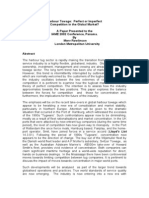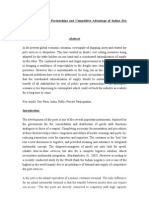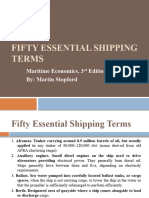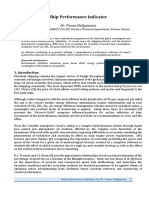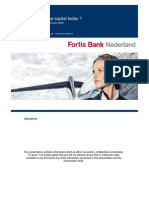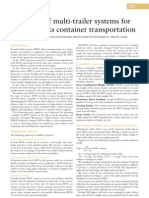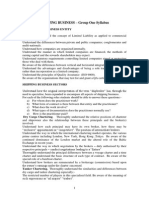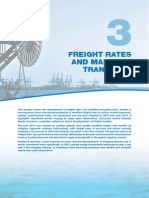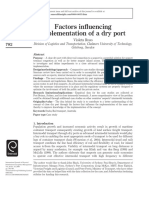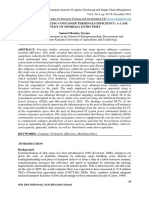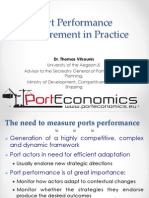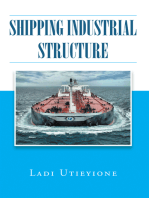Ports and Port Services 1 1
Ports and Port Services 1 1
Uploaded by
Marion KonesCopyright:
Available Formats
Ports and Port Services 1 1
Ports and Port Services 1 1
Uploaded by
Marion KonesCopyright
Available Formats
Share this document
Did you find this document useful?
Is this content inappropriate?
Copyright:
Available Formats
Ports and Port Services 1 1
Ports and Port Services 1 1
Uploaded by
Marion KonesCopyright:
Available Formats
Agenda Competition issues in ports and port services
Advancing economics in business
No safe harbours: competition issues
in ports and port services
Current competition questions in the ports sector cover competition between ports, and
between transport modes, countervailing buyer power and essential facilities. Drawing on
an OECD roundtable on competition in ports and port services, for which Oxera was asked
to provide a background paper, we examine these issues in the context of anti-competitive
practices, mergers and acquisitions, and privatisation and regulatory reform in the sector
In recent years, a number of competition authorities
have examined competition issues in the ports sector.
Market power in port services
For example: Under EU case law, a company could be considered to
have market power if it is able to behave independently
of its customers and competitors to an appreciable
− anti-competitive practices—in 2008, the French
extent.4 While the possession of market power in itself
Competition Council (Conseil de la Concurrence)
is not necessarily a problem, there is a risk that this
examined a joint venture formed between ship owner,
power might be abused. Such abuse can lead to
Maersk, and local stevedoring group, Perrigault, to
consumer harm and welfare detriment in the form of
operate a terminal at the French port of Le Havre.
higher prices, reduced output, reduced service quality,
The authorities found that the joint venture restricted
or reduced innovation.
competition;1
A competitive maritime sector is important to global
− mergers and acquisitions—in 2004, the German
economic growth, since international trade is
Competition Authority (Bundeskartellamt) considered
underpinned by waterborne transport. In 2009, a total
an acquisition through which Belgian company,
of 7.8 billion tonnes of cargo was loaded onto ships
Sea-Invest, took control of a fruit storage and
worldwide.5 In addition to this large volume of goods,
handling terminal at the port of Hamburg. No
maritime transport is important in terms of its value.
competition concerns were raised in this case, since
In 2007 the value of globally shipped goods was
the geographic market was found to include a number
around $4.6 trillion.6 The waterborne freight sector
of ports situated between Hamburg and Le Havre;2
continues to grow significantly; worldwide maritime
freight volumes doubled between 1990 and 2009.7
− privatisation and regulatory reform—in 2005,
the Netherlands Competition Authority (Nederlandse When considering market power in the ports sector,
Mededingingsautoriteit, NMa) conducted an four aspects are of particular relevance. The first
investigation to enable the country’s government relates to competition between different modes of
to assess whether additional specific rules on transport: if the price of port services increases,
competition were needed at the port of Rotterdam. customers might switch to other modes. The second
The NMa found that the port had a dominant position relates to competition between different ports: if prices
with regard to some services it provided, and increase at port A, customers might switch to port B.
recommended the introduction of sector-specific Third, where customers have an ability to switch, they
regulation.3 might be able to exercise countervailing buyer power
to keep prices down. Finally, where substitution
These cases prompt the question as to whether the between different modes of transport or different ports
ports or the providers of port services have market is limited, and customers do not have countervailing
power. What are the competitive constraints that buyer power, ports might be deemed to be essential
players face in the ports sector, and are ports essential facilities—an extreme form of market power.
facilities? Some of these important issues are
discussed below.
Oxera Agenda 1 September 2011
Competition issues in ports and port services
Competition between different low-value bulk goods transported by sea, higher-value
lighter goods by road, and expensive goods by air) is
modes of transport consistent with limited demand-side substitutability
The demand for port services is a derived demand, in between these modes—in particular, between maritime
that it depends on the demand for transport as a whole. and rail or road transportation. This implies that other
Transport demands can be met by different modes— modes of transport are likely to pose only a limited
eg, inland water, road, rail or air, and waterborne competitive constraint on transport by water.
transport may compete with the other modes of freight Nonetheless, sometimes even a limited constraint at
transport. If the price of one or more port services were the margin may be sufficient to make price increases
to increase, some shippers might decide to switch to a unprofitable, and hence widen the relevant market.
different mode, such as road or rail. Whether this is the case is an empirical question.
The prerequisite for any such substitution is the
availability of the required infrastructure for the other
Competition between different
mode of transport. Demand for transport by sea can ports—ability to compete for
be switched to transport by rail, say, only if the required hinterland traffic
rail infrastructure is in place. Any trade of bulk freight A port may also be constrained by competition from
between Australia and North America, for example, other ports. Since the customers of ports ultimately
would need to travel by sea, and hence through a port. require transportation from origin to final destination,
In this case, there would be no scope for demand-side ports that can economically receive goods from, or
substitutability between sea and other modes of deliver them to, these destinations can compete for
transport (although other types of good may be these customers. This is often referred to as
transported by air). competition for hinterland traffic.
When considering the degree of substitutability The ability of different ports to serve customers
between different modes of transport, it is also useful in a given hinterland needs to be assessed on a
to examine the value density of goods transported by case-by-case basis. In principle, however, a distinction
the different modes. Value density is a measure of the can be made between captive and contestable
average financial value per unit of volume or weight for hinterlands. All regions where one port has a
a commodity. Data published by the European substantial competitive advantage because of lower
Commission for 2008 shows that the value density transport costs to them (for example, owing to short
differs greatly between different modes of transport distances to the port’s customers’ final destinations)
(see Table 1 below)—for example, the average value belong to the captive hinterland. Such a port is likely
per tonne transported by sea was only a quarter of that to handle the majority of all cargoes to and from these
transported by road. Air transport had by far the highest regions. Competition between ports is more likely to
value density. occur in those regions where no single port has a
significant cost advantage over other ports.
Furthermore, UK data published by the Department for
Transport again suggests that certain types of good are An example of an area in a contestable hinterland
predestined to be transported by certain modes of is Austria, a country without a coastline, but with
transport. For example, the most common goods significant international import and export activities.
transported by inland water are oil and petroleum. In Data published in the Österreichische Seehafenbilanz
the case of rail, the most common good is coal, and for (produced by a weekly publication about transport
road it is foodstuffs, beverages and tobacco.8 logistics and business) shows that a total of eight
seaports currently service shippers moving goods
Observing differences in value densities and types of to and from Austria (Antwerp, Bremen, Constanta,
good transported by different modes of transport (ie,
Table 1 Value density of goods transported in 2008 (EU imports and exports)
Mode of transport € per tonne
Air 43,308
Road 3,289
Sea 865
Rail 470
Inland waterway 383
Source: European Commission (2010), ‘EU energy and transport in figures’.
Oxera Agenda 2 September 2011
Competition issues in ports and port services
Hamburg, Koper, Rijeka, Rotterdam, Trieste). The Le Havre and Gothenburg and includes the UK and
largest of these are Hamburg, Bremen, Antwerp and Ireland. In a recent Decision, the Commission was
Rotterdam to the north of the country, and Koper and inclined to consider that the northern European market
Trieste to the south.9 should be further segmented because it was observed
that, for various reasons, not all ports in northern
The port of Hamburg handles around a fifth of Austrian Europe are substitutable. Such reasons were draft
import and export volumes moved through ports; restrictions (the minimum depth of water that a ship or
around a quarter are moved through the port of Koper. boat can safely navigate); distance from main shipping
To determine whether ports that are as far apart as routes; distance from ‘transshipment markets’ (such as
Hamburg and Koper (1,300km by road, and much Scandinavia/the Baltic countries, Spain/Portugal and
further by sea) constrain each other to such an extent UK/Ireland); and capacity limitations that restrict
that neither has market power would require further switching.
analysis. In principle, however, the greater the overlap
between ports’ hinterlands, the greater the probability
that these ports constrain each other. See the box
Countervailing buyer power
below for a discussion of catchment areas. Independently of the outcome of the analysis of
existing competition between modes of transport and
different ports, a port’s ability to exercise any market
Competition between ports— power will depend on customers’ countervailing buyer
ability to compete for power. In such a situation, the buyer power of
transshipment traffic downstream operators—such as shipping companies
and brokers—prevents an upstream business from
In addition to hinterland traffic, ports may compete for acting to an appreciable extent independently of its
transshipment traffic where larger vessels use a port to customers.
transfer cargo to smaller feeder vessels. These feeder
vessels then transport the cargo on to ports that serve Countervailing buyer power might exist where buyers
the required hinterland. are large relative to their supplier(s), and where buyers
have the ability to switch between suppliers. In terms of
The distinction between hinterland and transshipment port users’ size, data published by the United Nations
traffic means that two ports that do not serve the same looking at the concentration of the global container
hinterland may still constrain one another if they shipping market indicates that several players hold a
compete for the same transshipment traffic. For significant global share of supply. At a global level, the
example, the port of Grimsby and Immingham, the UK’s largest four shipping lines (Maersk, MSC, CMA CGM
largest port, is unlikely to serve the same hinterland as Group, and Evergreen Line) accounted for 32% of all
the port of Rotterdam in the Netherlands. Nevertheless, containers transported by water in 2010.10 At a regional
the two ports might still constrain each other if they or port-specific level, concentration will tend to be at
compete for the same transshipment traffic between least as high. There is also evidence that concentration
Europe and other continents (given that both are has increased over time. This level of downstream
deep-water ports). concentration among port users could lead to
countervailing buyer power, particularly at ports with
The European Commission found that the geographic only a few main users. However, it is not sufficient to
market for stevedoring services for transshipment be large to have such power. Buyers must also be able
traffic was wider than that for hinterland traffic. The to credibly threaten to switch away a significant
Commission distinguished between the Mediterranean proportion of demand in the event of a price rise (which
market and the northern European market, which will depend on their outside options).
spreads across the geographic range between
Catchment areas
The European Commission found that the geographic open the question as to whether northern Europe should
area within which ports compete for hinterland traffic is be further divided, the widest geographic range being
determined by the ‘catchment area’ of the ports—ie, the Hamburg–Le Havre and the narrowest Hamburg–
inland geographic range to which containers can be Antwerp. Although the question was left open, in a
economically distributed. The Commission has identified recent decision the Commission was inclined to consider
three such geographic blocks in Europe: the UK and the narrower geographic range as more appropriate.2
Ireland; Northern Europe; and the Mediterranean.1 It left
Note: 1 The Commission has acknowledged, however, that the catchment area of some northern European and Mediterranean
ports might overlap with respect to the landlocked countries of west and central Europe, such as Switzerland and Austria. 2 The
Commission considered that there was limited competition between the German and French ports because of limited overlap in
their catchment areas and the higher handling fees at the German ports. See European Commission (2008), ‘Case No COMP/
M.5066 EUROGATE / APMM’, Commission decision of 5 June 2008.
Oxera Agenda 3 September 2011
Competition issues in ports and port services
In this regard, the Commission was doubtful that The Bundeskartellamt addressed the essential facility
shipping companies had countervailing buyer power question in the context of ferry services provided in the
over ports or port service providers. It found that Baltic Sea between the ports of Puttgarden in northern
shipping companies have difficulties in switching Germany and Rǿdby in southern Denmark. The ferry
between ports because of the complexity of reworking route Rǿdby–Puttgarden essentially links Denmark
schedules, timetables, loops and changes in terminal (and Sweden) with Germany and the rest of western/
cut-offs, which a switch would require. Another central Europe. There is no viable alternative to the
important switching constraint is the fact that, following ports of Rǿdby and Puttgarden since, due to their
a switch, a port’s customers—the shippers—will have location, duration of crossing, and connection to further
to adapt their logistical arrangements for transporting means of traffic, they are able to offer services that no
the cargo from the port to their final inland destination. other port can.
Essential facilities Scandlines GmbH is the owner and operator of the
port in Puttgarden and the only operator (through a
Where substitutability between modes of transport and subsidiary) of ferry services on the Rǿdby–Puttgarden
different ports is limited, and where customers cannot route. Following a complaint by two shipping
exercise countervailing buyer power, ports might be companies, the Bundeskartellamt found that the port
said to be ‘essential facilities’. When found to be an constituted an essential facility, and that Scandlines
essential facility, a port may be required to allow infringed competition law by refusing to grant access
downstream access on terms set under the competition to the complainants on reasonable, non-discriminatory
rules. terms.12 The Bundeskartellamt defined the relevant
upstream market as ‘organisation of port services in
A port might be deemed an essential facility when it
Puttgarden’—ie, a single port, because other ports in
fulfils the following three conditions:11
the region were not seen as viable alternatives.
− without access to the facility, firms cannot operate
economically in the related market—access is Conclusion
therefore essential, rather than ‘nice to have’; In recent years, there have been a number of
competition investigations in the EU concerning
− it enables a firm that is refusing to supply the ports and port services, and covering areas including
essential facility to reserve to itself the secondary anti-competitive practices, mergers and acquisitions,
(related) market; and as well as privatisation and regulatory reform. The
competitive constraints that ports or providers of port
− there is no objective justification for the refusal to services were found to face varied greatly. For
supply the facility. example, some ports were found to lack any
competitive constraints (eg, the port of Puttgarden),
Furthermore, a firm must control all the potential while others that were as far apart as Hamburg and
essential inputs into production in the second market— Le Havre were found to constrain each other (eg, in
reproduction of the facility must be economically or relation to fruit cargo-handling at the port of Hamburg).
physically unfeasible. The conditions for a facility to This illustrates the importance of an in-depth
be deemed essential are thus relatively strict, but may case-by-case assessment of the competitive
apply in the case of sea ports. constraints from other modes of transport and other
ports, as well as customers’ countervailing buyer
power.
Oxera Agenda 4 September 2011
Competition issues in ports and port services
1
Conseil de la Concurrence (2008), ‘Décision n° 08-D-19 du 31 juillet 2008 relative à une demande de mesures conservatoires de la
société AP Moller-Maersk’, July 31st.
2
Bundeskartellamt (2004), ‘Beschluss B9-101/04’.
3
Organisation for Economic Co-operation and Development, Directorate for Financial and Enterprise Affairs Competition Committee (2011),
‘Competition Concerns in Ports and Port Services’, Working Party No. 2 on Competition and Regulation, DAF/COMP/WP2/WD(2011), June
27th.
4
Court of Justice of the European Communities (1979), Hoffmann-La Roche & Co. AG v Commission of the European Communities,
Case 85/76.
5
United Nations Conference on Trade and Development (UNCTAD) (2010), ‘Review of Maritime Transport 2010’, Table 1.3.
6
World Shipping Council Trade Statistics (2007), ‘Top 20 Exporters of Liner Goods by Value, 2007’.
7
UNCTAD (2010), op. cit., Table 1.3.
8
Department for Transport (2008), ‘Delivering a Sustainable Transport System: The Logistics Perspective’.
9
Verkehr (2010), ‘Österreichische Seehafenbilanz’.
10
UNCTAD (2010), ‘Review of Maritime Transport 2010’.
11
These conditions were first set out in the Magill case. Radio Telefis Eireann and Independent Television Publications Ltd v European
Commission, joined cases C-241/91 P and C-242/91 P, European Court of Justice.
12
Bundeskartellamt (2011), ‘B9-188/05 “Scandlines”’, pp. 45 and 50.
If you have any questions regarding the issues raised in this article, please contact the editor,
Dr Gunnar Niels: tel +44 (0) 1865 253 000 or email g_niels@oxera.com
Other articles in the September issue of Agenda include:
− A common interest, different solutions: commonality in collective actions
Vincent Smith, Sheppard + Smith LLP
− Does pay TV pay too much? Profitability analysis in the context of market inquiries
− Why does it always rain on me? A proposed framework for flood insurance
For details of how to subscribe to Agenda, please email agenda@oxera.com, or visit our website
www.oxera.com
© Oxera, 2011. All rights reserved. Except for the quotation of short passages for the purposes of criticism or review, no part may
be used or reproduced without permission.
Oxera Agenda 5 September 2011
You might also like
- Brief Van EMA Aan Marcel de Graaff (FVD)Document8 pagesBrief Van EMA Aan Marcel de Graaff (FVD)robindeboer25100% (1)
- HY-TTC 32: Quick Start Guide For CODESYSDocument29 pagesHY-TTC 32: Quick Start Guide For CODESYSssleandroNo ratings yet
- Classification of Ship Running CostsDocument2 pagesClassification of Ship Running CostsVictor Ose Moses100% (1)
- ConsignmentDocument15 pagesConsignmentRajesh Nangalia100% (4)
- Competetion in Harbour TowageDocument16 pagesCompetetion in Harbour TowageDeanna BarrettNo ratings yet
- Significance of World Shipping and Sea-Borne TradeDocument26 pagesSignificance of World Shipping and Sea-Borne TradeIqtiran KhanNo ratings yet
- Port PricingDocument6 pagesPort PricingMahin1977No ratings yet
- Papers On Port AutomationDocument22 pagesPapers On Port AutomationSrikanth DixitNo ratings yet
- UNCTAD 1995 Strategi Port PricingDocument26 pagesUNCTAD 1995 Strategi Port PricingJon NomadenNo ratings yet
- Shipping Market OrganisationDocument5 pagesShipping Market Organisationyesuplus2No ratings yet
- Container Transshipment and Port Competition PDFDocument30 pagesContainer Transshipment and Port Competition PDFMohamed Salah El DinNo ratings yet
- Competition Excess Capacity and The PriceDocument25 pagesCompetition Excess Capacity and The PriceAli Raza HanjraNo ratings yet
- Literature Survey Port OperationsDocument14 pagesLiterature Survey Port Operationspragya89No ratings yet
- The Forwarder´s Concern: An introduction into the marine liability of forwarders, carriers and warehousemen, the claims handling and the related insuranceFrom EverandThe Forwarder´s Concern: An introduction into the marine liability of forwarders, carriers and warehousemen, the claims handling and the related insuranceNo ratings yet
- Basics of Chartering: Negotiation - Compatibility - Decision MakingFrom EverandBasics of Chartering: Negotiation - Compatibility - Decision MakingNo ratings yet
- Harbour Towage in Australia: Competitive Analysis and Regulatory OptionsDocument46 pagesHarbour Towage in Australia: Competitive Analysis and Regulatory OptionsCore ResearchNo ratings yet
- Unit 4 - SAFEDocument34 pagesUnit 4 - SAFETerique BrownNo ratings yet
- Dry Ports Public Private PartnershipDocument16 pagesDry Ports Public Private PartnershipgirishgujarNo ratings yet
- Fifty Essential Shipping TermsDocument11 pagesFifty Essential Shipping Termsmuhammad zulfadli senafi100% (1)
- Port Performance IndicatorsDocument21 pagesPort Performance Indicatorsrubyshaji96No ratings yet
- Ship Performance IndicatorDocument10 pagesShip Performance Indicatorc rkNo ratings yet
- Fortis Bank Maritime FinanceDocument43 pagesFortis Bank Maritime FinancebluepperNo ratings yet
- Port Info BasicDocument7 pagesPort Info BasicsherwinmitraNo ratings yet
- 6 An - Analysis - of - Turnaround - Time - in - Ref - ToDocument42 pages6 An - Analysis - of - Turnaround - Time - in - Ref - ToSudhakaranNo ratings yet
- Ship CostructionDocument86 pagesShip Costructionpasha vahediNo ratings yet
- Port Performance in Container Transport LogisticsDocument16 pagesPort Performance in Container Transport LogisticsSahdha P.No ratings yet
- Voyage CalculationDocument7 pagesVoyage CalculationAntonius Dimas AndityaNo ratings yet
- Efficiency of Multi-Trailer Systems For Ship To Stacks Container TransportationDocument3 pagesEfficiency of Multi-Trailer Systems For Ship To Stacks Container TransportationAlex GoussiatinerNo ratings yet
- Pre-Feasibility Desk Study Lamu Port Offshore Energy Industrial ParkDocument11 pagesPre-Feasibility Desk Study Lamu Port Offshore Energy Industrial ParkEric Mwangi NjorogeNo ratings yet
- Shipping Cycles Are Difficult To PredictDocument4 pagesShipping Cycles Are Difficult To PredictNikos NoulezasNo ratings yet
- SHIPPING BUSINESS - Group One SyllabusDocument5 pagesSHIPPING BUSINESS - Group One Syllabustahhan3107No ratings yet
- Maritime Economics: Yalqa Rizqi Azka 04211841000033Document15 pagesMaritime Economics: Yalqa Rizqi Azka 04211841000033Yalqa RizqiNo ratings yet
- Port Choice and Freight Forwarders (2009)Document10 pagesPort Choice and Freight Forwarders (2009)Laura Andrea Vega100% (2)
- Port AnalysisDocument43 pagesPort AnalysisSerte100% (1)
- India Port Report NumberedDocument270 pagesIndia Port Report NumberedzarrarNo ratings yet
- Maritime Logistics A Guide To Contemporary Shipping and Port Management From Kogan PageDocument11 pagesMaritime Logistics A Guide To Contemporary Shipping and Port Management From Kogan PageGAYATRI NAIDUNo ratings yet
- Port Pricing PDFDocument30 pagesPort Pricing PDFemkaysubha5977100% (2)
- Guided By: Prof. Seema Vyas: Presented By: Divya AgarwalDocument39 pagesGuided By: Prof. Seema Vyas: Presented By: Divya AgarwalDivya AgarwalNo ratings yet
- Determinants of Maritime Transport CostsDocument28 pagesDeterminants of Maritime Transport CostsKristiaan SturmNo ratings yet
- Ship Operations AssignmentDocument9 pagesShip Operations AssignmentBruno MadalenoNo ratings yet
- Managing Maritime Infrastructure: Lessons From UAE and ChinaDocument18 pagesManaging Maritime Infrastructure: Lessons From UAE and ChinaKantaJupolaNo ratings yet
- Quiz 3 Question 1Document8 pagesQuiz 3 Question 1Marchio Francis50% (2)
- Supply of Sea TransportDocument4 pagesSupply of Sea Transportyesuplus2No ratings yet
- Brief History of IncotermsDocument2 pagesBrief History of IncotermsWinact12100% (1)
- Freight Rate and Maritime Transport CostDocument14 pagesFreight Rate and Maritime Transport CostYoyokKurniawanNo ratings yet
- Containerized Shipping andDocument22 pagesContainerized Shipping andlfortesNo ratings yet
- India As A Transhipment Hub - TPPMDocument15 pagesIndia As A Transhipment Hub - TPPMdprakash9No ratings yet
- Chap9 TariffsDocument25 pagesChap9 TariffsMogan RajNo ratings yet
- Topic 4 - Bulk and Liner Service - Abril23Document58 pagesTopic 4 - Bulk and Liner Service - Abril23Kawtar El Mouden DahbiNo ratings yet
- Transportation Management Ms. Syeda Tooba SaleemDocument29 pagesTransportation Management Ms. Syeda Tooba Saleemfatima jawedNo ratings yet
- 28 - Maritime Economics - Stopford-Halaman-410-441 PDFDocument32 pages28 - Maritime Economics - Stopford-Halaman-410-441 PDFSidratul NugrahaNo ratings yet
- Factors - Influencing Implementation of A Dry Port PDFDocument17 pagesFactors - Influencing Implementation of A Dry Port PDFIwan Puja RiyadiNo ratings yet
- Chartering 130202003617 Phpapp01Document86 pagesChartering 130202003617 Phpapp01Krishna Das KotaNo ratings yet
- Training On Port Operations, Planning, Redesigning and StrategyDocument5 pagesTraining On Port Operations, Planning, Redesigning and Strategyboogieman1971No ratings yet
- Factors Influencing Container Terminals Efficiency A Case Study of Mombasa Entry PortDocument40 pagesFactors Influencing Container Terminals Efficiency A Case Study of Mombasa Entry PortMrManagerNo ratings yet
- Contrat of AffreightmentDocument29 pagesContrat of AffreightmentAnalisa Casanes PacunlaNo ratings yet
- Port Performance Measurement in Practice-Vitsounis-BelgradeDocument56 pagesPort Performance Measurement in Practice-Vitsounis-BelgradeBryan Yeo100% (1)
- Ports and Logistics Scoping Study in CAREC CountriesFrom EverandPorts and Logistics Scoping Study in CAREC CountriesNo ratings yet
- Contemporary Megaprojects: Organization, Vision, and Resistance in the 21st CenturyFrom EverandContemporary Megaprojects: Organization, Vision, and Resistance in the 21st CenturySeth SchindlerNo ratings yet
- Intermodal Transportation: Quintessence, Legal Challenges & Impact on Current Transportation Insurance SchemesFrom EverandIntermodal Transportation: Quintessence, Legal Challenges & Impact on Current Transportation Insurance SchemesNo ratings yet
- Implementation of Port State Measures: Legislative Template Framework for Procedures Role of Regional Fisheries Management OrganizationsFrom EverandImplementation of Port State Measures: Legislative Template Framework for Procedures Role of Regional Fisheries Management OrganizationsNo ratings yet
- Introduction To Electricity and MagnetismDocument34 pagesIntroduction To Electricity and MagnetismFaraiFrancisZawairaNo ratings yet
- Chapter-12 Hydro Generator and Excitation System TestsDocument13 pagesChapter-12 Hydro Generator and Excitation System TestsSe SamnangNo ratings yet
- Anglo Irish Case PRINTDocument5 pagesAnglo Irish Case PRINTAlyza C ArellanoNo ratings yet
- Econ 181 Lecture 7 BDocument60 pagesEcon 181 Lecture 7 BZel DionisioNo ratings yet
- SWOT AnalysisDocument38 pagesSWOT Analysissukhi9291100% (1)
- Ptu2 27-27 Die - Psst1011-UkDocument2 pagesPtu2 27-27 Die - Psst1011-UkParis AndreadisNo ratings yet
- Non Stastical Methods of Demand ForecastingDocument2 pagesNon Stastical Methods of Demand Forecastingrethvi50% (2)
- References Work From HomeDocument3 pagesReferences Work From Homeapi-564285765No ratings yet
- Fundamentals of Corporate Finance Canadian 9th Edition Brealey Test BankDocument25 pagesFundamentals of Corporate Finance Canadian 9th Edition Brealey Test BankMadelineTorresdazb100% (67)
- 2.1.2 Brosur Alternator Generator STAMFORD HC4Document1 page2.1.2 Brosur Alternator Generator STAMFORD HC4ウィリアムズ アンディNo ratings yet
- Power Transmission, Distribution and Utilization: Lecture# 13 &14: Underground CablesDocument29 pagesPower Transmission, Distribution and Utilization: Lecture# 13 &14: Underground CablesPhD EENo ratings yet
- Review of The APIRP14 Eerosional Velocity EquationDocument17 pagesReview of The APIRP14 Eerosional Velocity EquationTevriyudha Mardika100% (1)
- Research and Explain How A Region in Australia Has Been Affected by Its History andDocument1 pageResearch and Explain How A Region in Australia Has Been Affected by Its History andTashi ChophelNo ratings yet
- RPSSRules 1989 Uptodate 18-04.2022Document39 pagesRPSSRules 1989 Uptodate 18-04.2022ckhats15No ratings yet
- Multimodal Essay 1Document7 pagesMultimodal Essay 1api-490494291No ratings yet
- Scholar ShitDocument3 pagesScholar ShitJhon Gil DoradoNo ratings yet
- ACE and Mini-ACE - Where Are They Used - Data Device CorporationDocument15 pagesACE and Mini-ACE - Where Are They Used - Data Device CorporationRamu BanothNo ratings yet
- University of Gujrat Faculty of Management and Administrative SciencesDocument4 pagesUniversity of Gujrat Faculty of Management and Administrative SciencesHaseeb WaheedNo ratings yet
- EM Assignment - PDF 1Document13 pagesEM Assignment - PDF 1zohaibNo ratings yet
- Certificate of Incorporation: Hotels and Restaurants Association in Pampanga (Harp) IncDocument17 pagesCertificate of Incorporation: Hotels and Restaurants Association in Pampanga (Harp) IncAzenith Margarette CayetanoNo ratings yet
- Hacking With Python - Beginner's Guide PDFDocument194 pagesHacking With Python - Beginner's Guide PDFnarayan83% (6)
- LO2 Evaluate How To Motivate Individuals and Teams To Achieve A GoalDocument31 pagesLO2 Evaluate How To Motivate Individuals and Teams To Achieve A GoalBishal Singh100% (1)
- UM-3440 - 3440 User Manual - Ed 1.3Document201 pagesUM-3440 - 3440 User Manual - Ed 1.3wyi070707163.comNo ratings yet
- Secrets of Successful Creators BookDocument137 pagesSecrets of Successful Creators BookgileoscribdNo ratings yet
- Computer Concepts and Programming in 'C' (MCA - 103)Document318 pagesComputer Concepts and Programming in 'C' (MCA - 103)NAMAN KUMARNo ratings yet
- Pareto Principle: "The Vital Few and Trivial Many Rule"Document24 pagesPareto Principle: "The Vital Few and Trivial Many Rule"Muhammad Saleem BuluNo ratings yet
- Oracle Session TracingDocument19 pagesOracle Session TracingSHAHID FAROOQNo ratings yet




